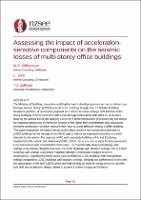Assessing the impact of acceleration-sensitive components on the seismic losses of multi-storey office buildings

Download
Date
2022-04-27Authors
Williamson, Michael
John, Luis
Sullivan, Timothy J.
Metadata
Show full item recordAbstract
The Ministry of Building, Innovation and Employment is developing advice on how to deliver Low Damage Seismic Design (LDSD) protection for buildings through their Tū Kahika: Building Resilience platform. A preliminary proposal for LDSD is to utilise a design drift limit for multi-storey buildings of 0.5% associated with a new damage control limit state (DCLS). A previous study by the authors found that applying a 0.5% drift limit without other provisions may not deliver the expected seismic loss performance because of the higher floor accelerations (and subsequent increased acceleration-sensitive losses) which result as a side effect of needing a stiffer building. This paper emphasises the need to design acceleration-sensitive non-structural components in LDSD buildings for the damage control limit state to reduce the expected annual loss to a level intended by the advice. The response of RC wall case-study buildings of 4- and 12-storeys, designed to both current code criteria and draft LDSD criteria, are used as input for loss assessment. Loss assessments were completed for three cases: 1) conventionally designed buildings with ceilings using standard fragility functions; 2) LDSD buildings with standard ceilings; and 3) LDSD buildings with ceilings using lower fragilities (stronger components designed to DCLS accelerations). Significantly lower losses were recorded for LDSD buildings with strengthened ceilings compared to LDSD buildings with standard ceilings, bringing loss performance in line with the expectations of the draft LDSD advice and highlighting the need for design advice to consider both drift and acceleration design criteria to achieve true low-damage performance.
